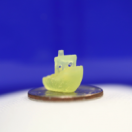SystemX Alliance News
Wed, 04/20/2022
Engineers at Stanford and Harvard have laid the groundwork for a new system for 3D printing that doesn’t require that an object be printed from the bottom up.
Mon, 03/28/2022
Using the data-crunching power of supercomputers, Reed transformed his expertise in physics and artificial intelligence into a place at the forefront of a promising new field.
Mon, 03/28/2022
With a simple design and some clever engineering, researchers devised a high-frequency, low-power, compact optical device that allows virtually any digital camera to perceive depth.
Wed, 03/23/2022
After discovering a groundbreaking way to create an elastic light-emitting polymer, Stanford chemical engineers have developed high-brightness, stretchy color displays.
Mon, 03/14/2022
A Stanford professor debuts a soft robotic finger designed to unlock the next generation of collaborative robotics.
Mon, 03/14/2022
A mechanical engineer develops technologies to propel tiny robots into new terrain inside the human body.
Mon, 03/07/2022
Optica (formerly OSA) is pleased to announce that Shanhui Fan, Stanford University, USA, has been selected as the 2022 recipient of the R.W. Wood Prize.
Wed, 03/02/2022
Promising technologies for converting wastewater into drinkable water produce a chemical compound that can be toxic, corrosive and malodorous.
Fri, 02/25/2022
A new study demonstrates – for the first time – how to versatilely program atoms to share information regardless of their spatial location, opening paths forward in fundamental physics and advanced computing.
Wed, 02/23/2022
Prof. Srabanti Chowdhury leads the Wide-Bandgap (WBG) Lab at Stanford with a diverse and inter-disciplinary group of students and postdocs.












